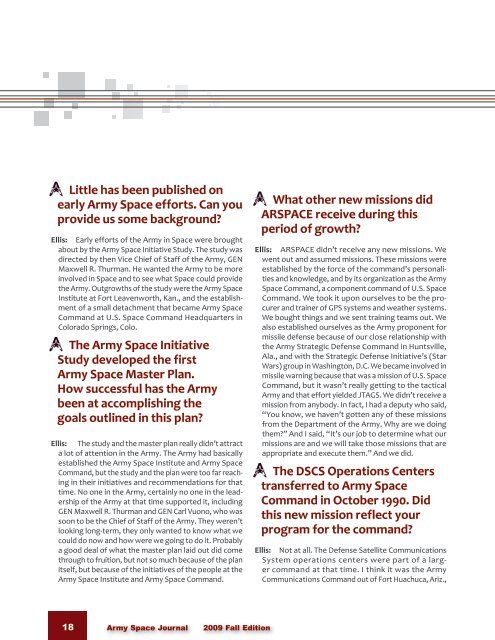Volume 8, Number 3 - Space and Missile Defense Command - U.S. ...
Volume 8, Number 3 - Space and Missile Defense Command - U.S. ...
Volume 8, Number 3 - Space and Missile Defense Command - U.S. ...
Create successful ePaper yourself
Turn your PDF publications into a flip-book with our unique Google optimized e-Paper software.
Little has been published on<br />
early Army <strong>Space</strong> efforts. Can you<br />
provide us some background?<br />
Ellis: Early efforts of the Army in <strong>Space</strong> were brought<br />
about by the Army <strong>Space</strong> Initiative Study. The study was<br />
directed by then Vice Chief of Staff of the Army, GEN<br />
Maxwell R. Thurman. He wanted the Army to be more<br />
involved in <strong>Space</strong> <strong>and</strong> to see what <strong>Space</strong> could provide<br />
the Army. Outgrowths of the study were the Army <strong>Space</strong><br />
Institute at Fort Leavenworth, Kan., <strong>and</strong> the establishment<br />
of a small detachment that became Army <strong>Space</strong><br />
Comm<strong>and</strong> at U.S. <strong>Space</strong> Comm<strong>and</strong> Headquarters in<br />
Colorado Springs, Colo.<br />
The Army <strong>Space</strong> Initiative<br />
Study developed the first<br />
Army <strong>Space</strong> Master Plan.<br />
How successful has the Army<br />
been at accomplishing the<br />
goals outlined in this plan?<br />
Ellis: The study <strong>and</strong> the master plan really didn’t attract<br />
a lot of attention in the Army. The Army had basically<br />
established the Army <strong>Space</strong> Institute <strong>and</strong> Army <strong>Space</strong><br />
Comm<strong>and</strong>, but the study <strong>and</strong> the plan were too far reaching<br />
in their initiatives <strong>and</strong> recommendations for that<br />
time. No one in the Army, certainly no one in the leadership<br />
of the Army at that time supported it, including<br />
GEN Maxwell R. Thurman <strong>and</strong> GEN Carl Vuono, who was<br />
soon to be the Chief of Staff of the Army. They weren’t<br />
looking long-term, they only wanted to know what we<br />
could do now <strong>and</strong> how were we going to do it. Probably<br />
a good deal of what the master plan laid out did come<br />
through to fruition, but not so much because of the plan<br />
itself, but because of the initiatives of the people at the<br />
Army <strong>Space</strong> Institute <strong>and</strong> Army <strong>Space</strong> Comm<strong>and</strong>.<br />
What other new missions did<br />
ARSPACE receive during this<br />
period of growth?<br />
Ellis: ARSPACE didn’t receive any new missions. We<br />
went out <strong>and</strong> assumed missions. These missions were<br />
established by the force of the comm<strong>and</strong>’s personalities<br />
<strong>and</strong> knowledge, <strong>and</strong> by its organization as the Army<br />
<strong>Space</strong> Comm<strong>and</strong>, a component comm<strong>and</strong> of U.S. <strong>Space</strong><br />
Comm<strong>and</strong>. We took it upon ourselves to be the procurer<br />
<strong>and</strong> trainer of GPS systems <strong>and</strong> weather systems.<br />
We bought things <strong>and</strong> we sent training teams out. We<br />
also established ourselves as the Army proponent for<br />
missile defense because of our close relationship with<br />
the Army Strategic <strong>Defense</strong> Comm<strong>and</strong> in Huntsville,<br />
Ala., <strong>and</strong> with the Strategic <strong>Defense</strong> Initiative’s (Star<br />
Wars) group in Washington, D.C. We became involved in<br />
missile warning because that was a mission of U.S. <strong>Space</strong><br />
Comm<strong>and</strong>, but it wasn’t really getting to the tactical<br />
Army <strong>and</strong> that effort yielded JTAGS. We didn’t receive a<br />
mission from anybody. In fact, I had a deputy who said,<br />
“You know, we haven’t gotten any of these missions<br />
from the Department of the Army. Why are we doing<br />
them?” And I said, “It’s our job to determine what our<br />
missions are <strong>and</strong> we will take those missions that are<br />
appropriate <strong>and</strong> execute them.” And we did.<br />
The DSCS Operations Centers<br />
transferred to Army <strong>Space</strong><br />
Comm<strong>and</strong> in October 1990. Did<br />
this new mission reflect your<br />
program for the comm<strong>and</strong>?<br />
Ellis: Not at all. The <strong>Defense</strong> Satellite Communications<br />
System operations centers were part of a larger<br />
comm<strong>and</strong> at that time. I think it was the Army<br />
Communications Comm<strong>and</strong> out of Fort Huachuca, Ariz.,<br />
18<br />
Army <strong>Space</strong> Journal<br />
2009 Fall Edition
















